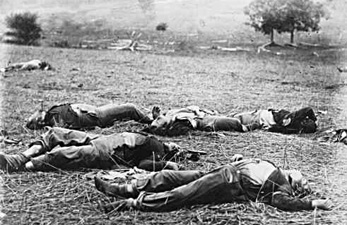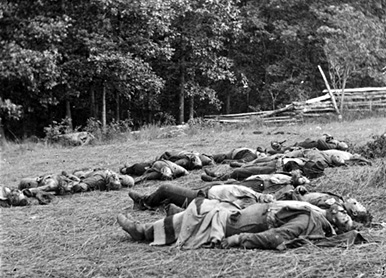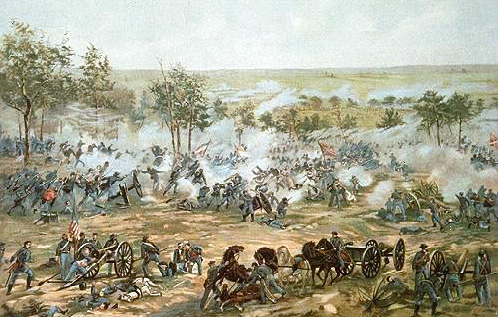![]()

|
|

|
|
The Pickett-Pettigrew assault (more popularly, Pickett’s Charge) momentarily pierced the Union line but was driven back with severe casualties. Stuart’s cavalry attempted to gain the Union rear but was repulsed. Battle: July 1-3, 1863 Principal Commanders: Maj. Gen. George G. Meade, US; Gen. Robert E. Lee, CS Forces Engaged: 158,300 total (US 83,289; CS 75,054) Estimated Casualties: 51,000 total (US 23,000; CS 28,000) |

|
|
On June 3, 1863, Lee began to move his Army of Northern Virginia across the Rappahannock. Hooker, who was aware of Lee's movements, shifted the Army of the Potomac northward, using it as a shield between Lee and the capital at Washington. Late in June, Hooker resigned his command, convinced that he had lost the confidence of the administration. On June 28, General George G. Meade replaced Hooker. Meade had been one of Hooker's corps commanders. On July 1 advance units of the two armies stumbled into each other near the little town of Gettysburg, Pennsylvania, 16 km (10 mi) north of the Maryland border. Both Lee and Meade realized that a battle was unavoidable. Fighting began that day. Union troops, after early reverses, managed to hold a strategic position on Cemetery Hill. |
 |
|
|
Bibliography: Catton, Bruce, The Final Fury (1974); Coddington, Edwin B., The Gettysburg Campaign (1968; repr. 1984); Dowdey, Clifford, Death of a Nation (1958; repr. 1988); Frassanito, W.A., Gettysburg (1976); Nofi, A., Gettysburg Campaign (1986); Perisco, Joseph E., My Enemy, My Brother: Men and Days of Gettysburg (1977); Pfanz, H.W., Gettysburg--The Second Day (1987); Wheeler, Richard, Witness to Gettysburg (1987; repr. 1989).